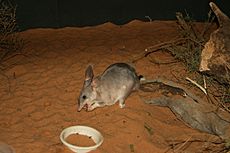Bilby facts for kids
Quick facts for kids Bilbies |
|
|---|---|
 |
|
| Scientific classification | |
| Kingdom: | |
| Phylum: | |
| Class: | |
| Infraclass: | |
| Order: | |
| Family: |
Thylacomyidae
Bensley, 1903
|
| Genus: |
Macrotis
Reid, 1837
|
| Species | |
The bilby is a cute, rabbit-like animal that lives in Australia. It's a type of marsupial, which means it carries its babies in a pouch, just like a kangaroo! You can find bilbies in deserts, dry forests, and grasslands across Australia.
These amazing animals have very big ears and are excellent at digging burrows. Sadly, bilbies are in danger of disappearing forever. They are also known as the rabbit-eared bandicoot because of their long ears.
Like all bandicoots, bilbies are nocturnal. This means they are most active at night. They use their strong, clawed feet to dig long, complex tunnels underground. These tunnels can be up to 5 feet (1.5 meters) long!
At Easter, you might see chocolate Easter Bilbies sold in Australia. These are a special Australian alternative to the Easter Bunny. Money from selling these chocolate bilbies often helps protect real bilbies.
Contents
What are Bilbies Like?
Bilbies have a long snout, like a bandicoot, and very large ears. These big ears help them release heat and stay cool in the hot Australian climate. Bilbies are usually about 11 to 22 inches (29–55 cm) long.
Compared to other bandicoots, bilbies have a longer tail, bigger ears, and soft, silky fur. Their large ears also give them excellent hearing. Bilbies are omnivores, meaning they eat both plants and animals. They don't need to drink water because they get all the moisture they need from their food.
What Do Bilbies Eat?
Bilbies eat many different things. Their diet includes:
- Insects and their larvae (baby insects)
- Seeds
- Spiders
- Bulbs (like onion plants)
- Fruit
- Fungi (like mushrooms)
- Very small animals
They find most of their food by digging or scratching in the soil. They also use their very long tongues to catch tasty treats!
Bilby Burrows
Bilbies are amazing diggers. They build huge tunnel systems using their strong front legs and sharp claws. A bilby usually has about a dozen burrows in its home area. They move between these burrows to stay safe from predators and to escape the heat of the day.
A female bilby's pouch faces backwards. This is very helpful! It stops dirt from getting into the pouch while she is digging.
Bilbies have a very short gestation period, which is how long they are pregnant. It's only about 12 to 14 days, one of the shortest among all mammals!
Helping Bilbies

Bilbies are slowly becoming endangered. This means their numbers are getting very low. They are in danger because of:
- Losing their natural homes
- Changes to their environment
- Competition with other animals for food and space
There is a national plan to help save bilbies. This plan includes:
- Captive breeding: Raising bilbies in special facilities to increase their numbers.
- Monitoring populations: Keeping track of how many bilbies are left and where they live.
- Reintroducing bilbies: Releasing bilbies back into areas where they used to live.
The Easter Bilby
One popular way to help bilbies is through the chocolate Easter Bilbies. Selling these chocolates helps raise money for bilby protection and research. It's a fun way to spread awareness about these special animals.
Successful Reintroductions
Many efforts have been made to bring bilbies back to their old homes.
- In 2000, bilbies were successfully reintroduced into the Arid Recovery Reserve in South Australia.
- In 2006, six bilbies were released into a safe area in Currawinya National Park in Queensland.
- Bilbies have also been successfully reintroduced on the Peron Peninsula in Western Australia as part of a program called Western Shield.
- Other conservation areas, including islands and sanctuaries like Scotia and Yookamurra, have also had success.
There is also a very successful bilby breeding program at the Kanyana Wildlife Rehabilitation Centre near Perth, Western Australia. These programs are helping to ensure bilbies have a future.
Images for kids
See also
 In Spanish: Bilbies para niños
In Spanish: Bilbies para niños

